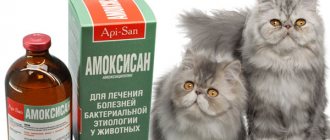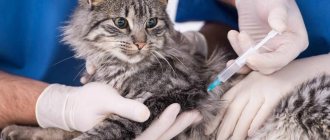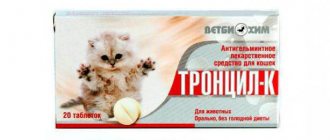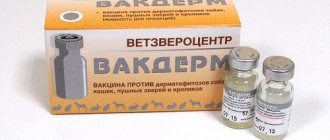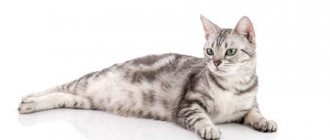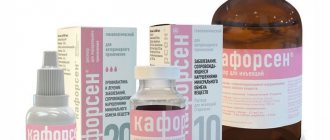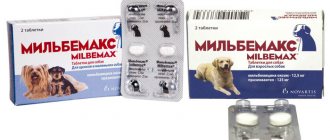Form and composition
Stomorgyl is available in tablets. They are packaged in blisters and placed in cardboard packaging with instructions for use.
The medicine consists of active ingredients:
- metronidazole;
- spiramycin.
Stomorgyl is available for sale in 3 types with different ratios of the main components:
- Stomorgyl 2 (weight 120 mg): spiramycin – 150 thousand IU, metronidazole 25 mg;
- Stomorgyl 10 (weight 600 mg): spiramycin 750 thousand IU, metronidazole – 125 mg;
- Stomorgyl 20 (weight 1200 mg): spiramycin 1,500 thousand IU, metronidazole 250 mg.
The drug additionally contains: aluminum hydroxide – 4%, sorbitol – 2%, white dextrin – 0.15%, gelatin – 0.25%, magnesium stearate – 1%, starch – 90%.
general description
Stomorgyl is an antibacterial agent in tablet form. The small tablets are yellow in color. In addition, each tablet has a groove that allows it to be divided into two equal parts. Its presence is especially important for owners of small cats, since antibiotic doses are calculated based on weight. Blisters are used to package tablets.
Depending on the concentration of the active components, the drug is produced in three versions - Stomorgyl 2, 10 and 20. For cats, the medicine with the lowest concentration is usually used. This makes it easier to calculate the correct dose and prevent an overdose, the consequences of which will negatively affect the animal’s well-being and general health. For large cats and cats, Stomorgyl 10 is sometimes used.
Note! The drug Stomorgyl 20 is intended for large dogs; it is prohibited for use in cats. It is not possible to calculate the correct dose.
No special conditions need to be observed during storage. Without fear that the drug will lose its pharmacological properties, it can be placed in a veterinary medicine cabinet or placed on the top shelf of a cabinet. The main thing is that it is away from the sun's rays, and the air temperature is positive, but does not exceed 25 degrees Celsius.
Pharmacological properties
The main substances of the medicine are strong antibiotics that can completely kill the organisms of such microbes as:
- staphylococci;
- streptococci;
- meningococci;
- chlamydia;
- clostridia;
- Trichomonas;
- Helictobacter pylori;
- mycoplasmosis.
Metronidazole prevents bacteria from breathing. The component immediately enters the bloodstream in full through the walls and vessels of the stomach and intestines. High concentrations in blood plasma and saliva occur within 60 minutes.
Spiramycin is a natural antibiotic that prevents bacterial cells from growing and developing. It is quickly absorbed into the cat's intestinal walls. The maximum concentration in blood plasma is reached after 3-5 hours, and in saliva - 3-7 hours.
Together, these two components prevent bacteria from developing and multiplying and lead to their inevitable death.
The medicine leaves the cat’s body naturally, the vast majority through urine or feces. If the cat is feeding its offspring, the drug will be partially excreted in the mother's milk.
Feedback from cat owners
After 3 days of taking Stomorgil, the cat began to eat normally and painlessly and the smell went away from his mouth. And we forgot about it for almost a year and thought that everything was cured. But the inflammation began again and more intensely, turned into a chronic form, and the torment began every two to three months. The drugs and ointments have changed, but of all of them, I only single out Stomorgyl. The drug is of course expensive, but its effectiveness with the correct dosage is simply off scale. The cat could not eat at all, shied away from food, and after one meal, he could at least swallow without chewing small pieces.
Anuta777
https://irecommend.ru/content/bystrodeistvuyushchii-i-effektivnyi
Stomorgil has very high efficiency. Within a day, it relatively relieved the pain and inflammation and the cat began to show interest in food (milk, kefir, broth), and after the second dose this foul smell from the mouth almost disappeared. And already on the third or fourth day, dry food was snatched away from the big cat. The only thing is that because the shell was broken, the cat had diarrhea (but I only gave it for 5 days) and/or because she couldn’t eat and drank only warm milk. Now, after Stomorgil and a course of treatment with an immunomodulator (Gamavit) and a probiotic, the animal is quite healthy, active, eats with appetite and is gradually getting used to it.
Marvelous777
https://otzovik.com/review_6092764.html
When is the medicine prescribed?
Stomorgyl is prescribed for infections of bacterial origin that are sensitive to Metronidazole and Spiramycin. Taking the medicine is possible and effective at any stage of the disease, but it is recommended to start treatment in the initial or acute period.
The complex use of Stomorgyl with other drugs in the fight against various diseases of the oral cavity (for example, stomatitis, gingivitis, periodontitis and others) enhances their effect.
It should be noted that the effectiveness increases when these diseases are caused by pathogenic bacteria sensitive to Metronidazole and Spiramycin.
The product perfectly helps with bleeding gums, prevents the appearance of plaque, as well as during surgical interventions in the oral cavity. It is worth noting that if the mucous membrane is treated with this drug, it can be considered sterile.
Dosage of the drug
When treating a pet with the drug Stomorgyl, the dosage is determined individually by the veterinarian, or in accordance with the instructions:
- Stomorgyl 2 for cats weighing up to 2 kilograms is prescribed 1 tablet.
- Stomorgyl 10 for an animal weighing 5 kilograms is prescribed half a tablet. If the animal weighs 10 kilograms, you should take 1 tablet.
- If the cat weighs close to 15 kilograms, half a tablet of 1200 mg is prescribed. If the animal weighs 20 kilograms, then the whole tablet should be taken.
At any dosage, administration is carried out once every 24 hours. It is worth noting that crushing the tablet is unacceptable; it is only allowed to divide it in half. Divide the tablet only if it is obvious that the cat will not be able to swallow it whole. Stomorgil has an unpleasant bitter taste.
If the drug is crushed, its particles may remain in the animal’s mouth and thereby cause an unpleasant impression and sensation from the treatment procedure.
The course of taking the medicine is from 5 to 10 days and depends on the complexity of the disease and the characteristics of the animal’s body.
Adverse reactions
The medicine is well tolerated by “patients” and does not lead to negative reactions.
Side effects may be caused by intolerance to the main components of the drug Stomorgyl. In this case, the cat will experience:
- allergic reactions;
- vomit;
- diarrhea;
- increased salivation.
If undesirable consequences occur during use, you should immediately stop taking it and consult a specialist. The veterinarian will help you find an alternative solution.
If allergic manifestations occur, use continues in combination with antihistamines.
In case of overdose, you can observe: increased secretion of saliva, disorders of the nervous system and gastrointestinal tract. This situation requires immediate consultation with a veterinarian.
No particular effects of the drug were detected during initial use or upon its discontinuation.
The course of treatment should be carried out according to the instructions, or individually prescribed by the attending veterinarian, and interruptions in use should not be allowed if the drug has a positive effect. If the drug was interrupted, it is necessary, if possible, to restore it and continue according to the same regimen.
The medicine is eliminated from the body within 3 days.
Contraindications for use
According to the instructions for use, Stomorgyl is prohibited from being used in combination with other antibiotics. You should also stop taking it if your body is hypersensitive to the components of the antibiotic.
Taking the medication is not contraindicated during pregnancy and lactation. However, in case of heart, kidney and liver failure, treatment is carried out only after consultation with a specialist and under his supervision.
How to take the drug correctly
As a rule, prescribing the dosage of the drug and the duration of the course of treatment is the responsibility of the veterinarian. But there are general recommendations for using this product:
- the dosage is calculated based on the pet’s body weight: for each kg of weight, 75,000 IU of spiramycin and 12.5 mg of metronidazole, that is, half a tablet of Stomorgyl 2 (if the pet weighs 2 kg, then its single dose is one tablet of the antibiotic Stomorgyl 2);
- Stomorgyl 10 is intended for pets weighing 10 kg;
- Stomorgil 20 - for pets weighing 20 kg;
- if the cat weighs 5 kg, then use half of the Stomorgyl 10 tablet;
A tablet dispenser simplifies the process of giving a tablet to an animal
From personal experience I was convinced that a tablet dispenser is a very necessary and useful thing. I have a cat that I deworm once a year. Unfortunately, she is reluctant to eat even meat-flavored drugs and constantly spits them out. Any attempt to “throw” a tablet into the oral cavity ended with scratched hands. To simplify this process, on the advice of a pet store consultant, I purchased this miracle device. And indeed, with a light touch of your finger, the tablet ends up in the pet’s mouth.
Video: how to properly give a pill to a cat
Storage conditions and price
The medicine should be stored in a place away from direct sunlight and with air humidity of no more than 50%, at a temperature range of 4 to 25 degrees, in intact packaging. The drug should be out of reach of children and pets; contact with food and feed should be avoided.
The shelf life is no more than 3 years, subject to all the above conditions. After the expiration date, the medicine should not be used. Unused drug must be disposed of in accordance with the requirements of regulations on the destruction of drugs and medicines.
On average, the price of the drug is 500-1500 rubles and depends on the dose of the drug.
Administration of medication to an animal
While taking the medicine, those around you should remain calm, talk quietly to the cat, and pet it. Excitement and anxiety can frighten the animal and make it wary. If the owners are not confident in their actions, then it is better to use the help of a specialist.
The approach to the animal should be individual, depending on the nature of the pet: calm or hot-tempered.
Some tips:
- The process must take place with the participation of at least 2 people, one will hold the head, the second the animal.
- The cat's head needs to be tilted back a little.
- Press your fingers on the gum where the teeth are missing to release the lower jaw.
- For better glide, the tablet should be dipped in vegetable oil.
- Place the tablet on the root of the tongue.
- Pour water into the animal's mouth for a sip.
In order to make the procedure as safe as possible, you need to use a blanket, or purchase a special cage for this purpose at the veterinary store.
When working with this medicine, you should be guided by the principles of personal hygiene and safety precautions. Before using the medicine and after it, you should thoroughly wash your hands with soap and water.
For people who are highly sensitive to the components of the drug, it is necessary to avoid direct contact with the drug . If an allergy occurs or the medicine is ingested, you must urgently seek help from the hospital. Doctors must provide instructions for the drug or a box of it.
Reviews from veterinarians
First you need to determine the cause of stomatitis, because... it does not develop out of the blue. First of all, it is necessary to be tested for infections such as calicivirus, viral immunodeficiency, leukemia. Stomorgyl or any other antibiotic is only an auxiliary therapy that will only have a temporary positive effect. The cause must be identified and treated. You can repeat a course of antibiotics or use a different antibiotic even a few days after stopping the previous drug, but this is unlikely to completely solve the problem.
Therapist N.S. Smirnova
https://www.biocontrol.ru/forum/viewtopic.php?f=5&t=2646
Yes, the photo shows redness of the gums as with gingivitis... As for the reasons - gingivitis, and even with the gradual loss of almost all teeth, often occurs in cats against the background of immunodeficiency conditions (with latent leukemia or feline viral immunodeficiency), immune-mediated diseases, diabetes mellitus, bacterial infections. To exclude the first two (leukemia and immunodeficiency), blood tests are taken for PCR diagnostics (sometimes the result can be false negative). Also, for a general idea, it would not be a bad idea to evaluate the TCA of the blood (that is, a general analysis with a leukocyte formula). Local treatments with dental gel would be suitable for therapy, and it is also possible systemically, but in the form of tablets (Stomorgyl, for example), but the decision to use systemic treatment can only be made after an in-person examination.
Ekaterina Mekhtieva Veterinary dermatologist “VetState”
